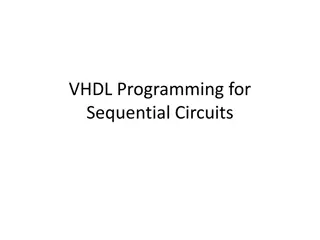Understanding Flip-Flop Timing Parameters in Digital Systems
In digital systems, flip-flop timing parameters are crucial for proper operation. Synchronous inputs must remain stable before and after the clock edge to ensure correct storage of values. Clock frequency, setup time, hold time, and propagation delay play key roles in signal integrity. By considering these parameters, the efficient design and functioning of flip-flops can be achieved.
Download Presentation

Please find below an Image/Link to download the presentation.
The content on the website is provided AS IS for your information and personal use only. It may not be sold, licensed, or shared on other websites without obtaining consent from the author. Download presentation by click this link. If you encounter any issues during the download, it is possible that the publisher has removed the file from their server.
E N D
Presentation Transcript
ECE 352 Digital System Fundamentals Flip-Flop Timing Parameters Flip-Flop Timing Parameters 1 1
Flip-Flop Timing Parameters A flip-flop only behaves the way we expect it to if we make sure that its synchronous inputs do not change too close to the clock edge If a synchronous input changes too close to the clock edge, the correct value may not be stored! Flip-Flop Timing Parameters The output of a flip-flop will not update instantaneously at the active clock there will be a delay before Q is known to be correct 2 2
Flip-Flop Timing Parameters We need to ensure that our clock frequency is not too fast for the design of our circuit A newly-stored value must propagate through its FF and any combinational logic on the way to the next FF, and arrive early enough before the next clock edge Flip-Flop Timing Parameters We need to know: When do values need to get to the FF? How long do they need to stay after the edge? How long for them to propagate through the FF? How long is the path between flip-flops? based on the design of the logic circuit based on flip-flop design & technology 3 3
Flip-Flop Setup Time (ts) Synchronous flip-flop inputs must be stable for a certain time before each active clock edge Flip-Flop Timing Parameters clock period CLK ts ts Input must not change 4 4
Flip-Flop Hold Time (th) Synchronous flip-flop inputs must be stable for a certain time after each active clock edge Flip-Flop Timing Parameters clock period CLK th th Input must not change 5 5
Flip-Flop Propagation Delay (tpd) The flip-flop output will not reflect the new stored value until some time after the active clock edge Flip-Flop Timing Parameters clock period CLK tpd tpd Output not yet updated 6 6
Flip-Flop Timing Parameters clock period CLK Flip-Flop Timing Parameters ts th ts th D Input must not change tpd tpd Q Output not yet updated 7 7
Flip-Flop Timing Parameters Setup (ts) and hold (th) times: Changes to FF input during these times may or may notbe reflected in the stored value DO NOT change the FF input values during these times This also means you should not have the circuit inputs change on active clock edges when simulating a circuit! Propagation delay (tpd) Takes some time after the clock edge for the stored FF value to show up at outputs Clock period Clock can only go so fast and still have the FFs behave in an expected manner due to the above Flip-Flop Timing Parameters 8 8
ECE 352 Digital System Fundamentals Flip-Flop Timing Parameters Flip-Flop Timing Parameters 9 9























